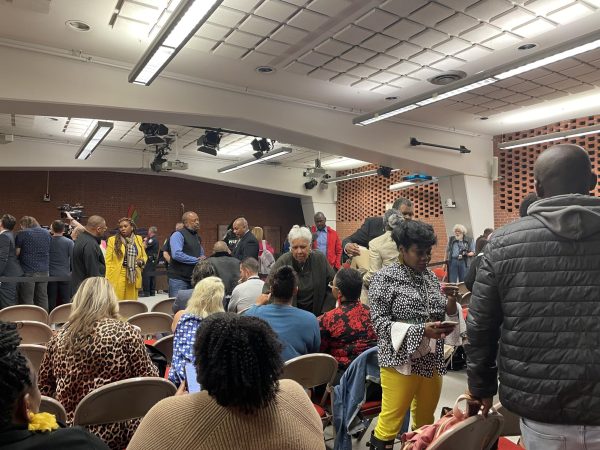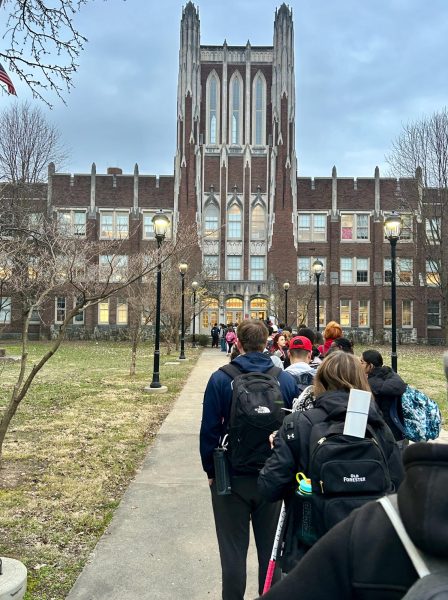What the assignment plan proposal means for Manual
May 23, 2022
This piece was submitted by Caleb Masterson (10, J&C).
The new Student Assignment Plan has generated much public discourse since JCPS released it on March 30 this year. For those unaware, this new plan seeks to revamp the current student assignment plan by giving students in the West End new school choices that are closer to home, and according to JCPS, “…[Ensure] that all students have equitable access to school choice options within JCPS.”
While the plan to create choice zones in the West End does not directly impact Manual, the school will most likely be impacted by other facets of the proposal, which may change JCPS magnet programs significantly. The plan seeks to retool JCPS magnet programs by replicating popular magnets, axing unsuccessful ones, creating diversity targets and prohibiting ‘exiting’ (school-initiated dismissal of students from a school or program because of poor behavior, grades, or attendance). The first phase of the plan will go into effect for the 2023-24 school year, if approved by the JCPS Board of Education. The board will vote on the proposal as early as June.
Dr. Marty Pollio, the Superintendent of JCPS, joined RedEye earlier this month for an interview, providing some clarifying information concerning ways that this new plan could affect duPont Manual.
Transparency in admissions
JCPS wishes to “increase transparency and ease of understanding” within the district’s magnet applications through this new plan. Dr. Pollio made a point of desiring transparency in the admissions processes of magnet schools, especially Manual, in the interview.
“Having transparency– it’s very clear, if you get in, you know why you got in. If you didn’t get in… there’s clarity on why you didn’t get in. That’s a big part of [the plan] for Manual,” Pollio said. “What you can have are rubrics [for admissions] that say, ‘here are the benchmarks you have to meet.” That’s what we’re asking and wanting, is that it’s clear, that there’s criteria that’s very clear and equitable.”
Pollio provided an example of how this hypothetical rubric system of admissions could work: “When my daughter did her application and her tryout for musical theater, there should have been a rubric to say ‘here are the points you collected on the rubric, this gets you in or it didn’t get you in.'”
In addition to this, RedEye asked Pollio about whether Manual would continue carrying out its own admissions under the new plan, or if admissions would be moved to the JCPS Central Office.
“There’s going to be a collaboration between the local school and the central office, to sit down with central office and say, ‘Okay, here’s the criteria for this program. We have 80 students who have met the criteria for this program, but we only have 40 seats.’ So now we have to figure out ways that we [go through the admissions process for] these 80, making sure there’s equitable access to opportunities and making sure there is going to be diversity within that program. It will be a collaboration together,” Pollio stated.
“Our Central Office Student Assignment Team is highly trained on best practice. Best practice for us are the Magnet Schools of America guidelines. It’s an organization that provides research-based solutions to developing and creating the best magnets that provide access and opportunity for all students. Our staff is trained by them on best practice,” Pollio added.
Under the new plan, Pollio foresees budget increases for schools depending on student need, but did not predict major changes to Manual’s budget.
“Historically, what has happened in the budget process is every student is worth ‘x’ amount of dollars to the school’s budget. I believe this: there are students in JCPS who need a lot more support. Students who have those needs should bring more dollars to the school’s budget, but I don’t see any impact to duPont Manual’s budget at all,” Pollio stated.
Diversity targets
One of the goals of JCPS’ plan is to “provide Black and Brown students with a choice to attend thriving, diverse schools close to home with strong programs.” At the plan’s introduction at the JCPS board meeting on April 26, Amanda Averette-Bush, Assistant Director of Student Assignment, clarified this: “We want our magnets to reflect our student demographics of our district, and that is for each individual program that we have within the district.”
That means that for schools like Manual, every magnet program within the building would be assessed individually to ensure that each is meeting diversity targets. Whether these policies are legal is still up for debate.
“The Supreme Court decided in 2008 that you can’t make admittance to schools based on race,” Pollio commented.
There have been a myriad of legal challenges nationwide to policies seeking to increase diversity in educational programs, including a similar diversity policy enacted in 2020 at Thomas Jefferson High School for Science and Technology in Virginia. That policy drew litigation and was ruled by a federal judge to be “unconstitutional racial balancing”.
Board Member Linda Duncan, representing District 5, voiced her own concerns with the proposed diversity targets at the April 26 board meeting. “When interests are so specific, some programs will draw more people to the program. Regardless of what ethnic group they are, they will draw more people just because of the nature of the program. . . I don’t think [diversity targets are] a reasonable approach,” Duncan said. At the meeting, Duncan instead stated she supported fluid diversity ranges instead of a concrete diversity level for all programs.
JCPS magnet schools were originally created to counter diversity. Averette-Bush said at the April 26 board meeting that magnets were devised as a way to promote integration during the period of desegregation. However, she said that at the time, JCPS did not want to lose students to private schools because of fleeing from integration. Thus, JCPS magnets were generally created to cater to more affluent, less diverse constituents of the school district’s population.
Pollio provided an anecdote in RedEye’s interview: “[In 1971], Manual was considered one of the worst-performing schools in the state, because it served high-poverty areas and had a resides. In 1984, the board decided to make it a magnet. It took away the resides and sent most of the students to Iroquois. Iroquois, as a result, has become a school that is considered by the press to be failing, where at the same time, Manual has become very low-poverty and the best school in the state.”
Ending school-initiated exits
Under the new plan, school-initiated exits because of poor behavior, grades, or attendance would no longer be possible, and instead, more support and intervention would be given to those falling behind or misbehaving.
“When a student is kicked out of a school, the trajectory of their education continues to decline pretty rapidly. Research and best practice says kids should not be kicked out of magnet schools,” Pollio said.
This would mean Manual would no longer have the opportunity to dismiss students. This would not mark a major change for Manual. Pollio said of the school, “Interestingly enough, duPont Manual very rarely eliminates or kicks out a student.” However, this would be a bigger change for other programs; 8,190 students were exited from JCPS magnet schools and programs from 2011-2018.
The bottom line
Dr. Pollio wishes to bring more transparency to the admissions process of Manual. He wants the criteria for admissions to be clear to students so that they know why they were or were not admitted into a magnet. He does not predict a major change to Manual’s budget, but wishes to implement diversity targets for every program and end school-initiated exits. He also foresees some sort of collaboration between Central Office and Manual for admissions, but he did not share how the Central Office would be qualified to determine if a student would be a fit for the magnet to which they are applying. Whether Manual would remain criteria-based or transition into some sort of lottery system remains undivulged as well.
The Student Assignment Plan is expected to be implemented in phases over several years, and is expected to be approved by the JCPS Board of Education over the summer. Will Manual see major, lasting change? A great amount of details still remain unaddressed; for now, it’s safe to assume the school will see some form of alteration, but the extent to which Manual will change remains to be seen.

















